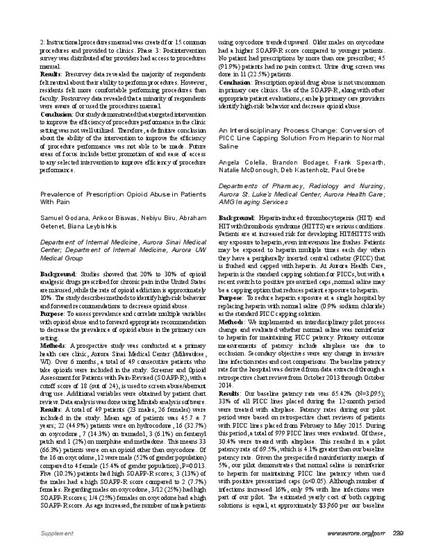
- opioid,
- drug abuse,
- chronic pain,
- prevalence
Background: Studies showed that 20% to 30% of opioid analgesic drugs prescribed for chronic pain in the United States are misused, while the rate of opioid addiction is approximately 10%. The study describes methods to identify high-risk behavior and forward recommendations to decrease opioid abuse.
Purpose: To assess prevalence and correlate multiple variables with opioid abuse and to forward appropriate recommendation to decrease the prevalence of opioid abuse in the primary care setting.
Methods: A prospective study was conducted at a primary health care clinic, Aurora Sinai Medical Center (Milwaukee, WI). Over 6 months, a total of 49 consecutive patients who take opioids were included in the study. Screener and Opioid Assessment for Patients with Pain-Revised (SOAPP-R), with a cutoff score of 18 (out of 24), is used to screen abuse/aberrant drug use. Additional variables were obtained by patient chart review. Data analysis was done using Minitab analysis software.
Results: A total of 49 patients (23 males, 26 females) were included in the study. Mean age of patients was 45.7 ± 7 years; 22 (44.9%) patients were on hydrocodone, 16 (32.7%) on oxycodone, 7 (14.3%) on tramadol, 3 (6.1%) on fentanyl patch and 1 (2%) on morphine and methadone. This means 33 (66.3%) patients were on an opioid other than oxycodone. Of the 16 on oxycodone, 12 were male (52% of gender population) compared to 4 female (15.4% of gender population), P = 0.013. Five (10.2%) patients had high SOAPP-R scores; 3 (13%) of the males had a high SOAPP-R score compared to 2 (7.7%) females. Regarding males on oxycodone, 3/12 (25%) had high SOAPP-R scores; 1/4 (25%) females on oxycodone had a high SOAPP-R score. As age increased, the number of male patients using oxycodone trended upward. Older males on oxycodone had a higher SOAPP-R score compared to younger patients. No patient had prescriptions by more than one prescriber; 45 (91.9%) patients had no pain contract. Urine drug screen was done in 11 (22.5%) patients.
Conclusion: Prescription opioid drug abuse is not uncommon in primary care clinics. Use of the SOAPP-R, along with other appropriate patient evaluations, can help primary care providers identify high-risk behavior and decrease opioid abuse.
Godana S, Biswas A, Biru N, Getenet A, Leybishkis B. Prevalence of prescription opioid abuse in patients with pain. J Patient Cent Res Rev. 2016;3:239.
